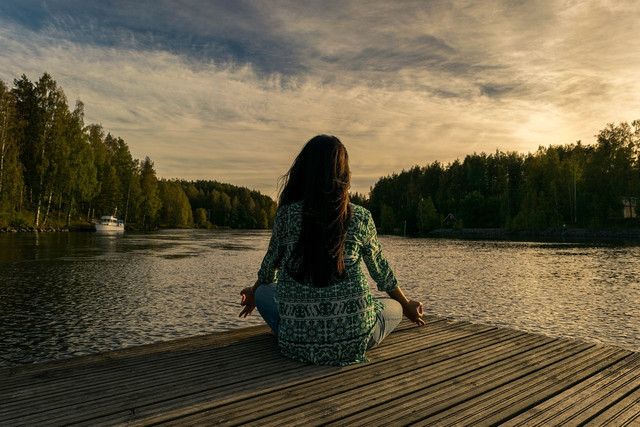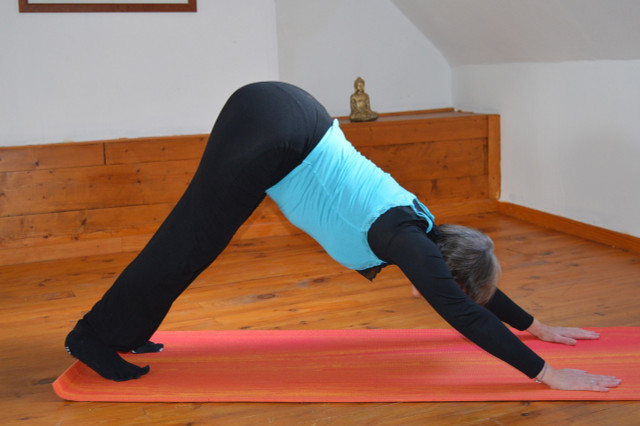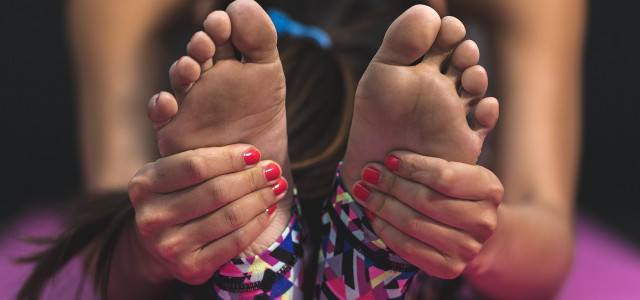What is yin yoga and why might it be right for you? This soft and restorative practice is excellent for the body and soul. Here are our top 10 yin yoga poses.
What is yin yoga?
Yin yoga is a variation of hatha yoga, which uses or adapts yoga’s traditional postures. The main differences are that the movements are slower, and postures are held for longer periods of time, allowing for deeper release. You become more aware of your breath, the beat of your heart and meditation in stillness.
Yin yoga can be quite lyrical, too, as awareness moves into the body and mind, and some practitioners may become more poetic in their language. You are encouraged to accept this softness and let your body guide you.
Yin is, in essence, the opposite of yang energy. In Chinese philosophy, yin and yang represent polar opposites, such as sun and moon, light and dark and activity vs. stillness. In yoga, the yang may focus more on high-intensity postures (as in Bikram Yoga), whereas the yin encourages the focus inwards (working the muscles and joints, too, of course). In some cases, it can be a more difficult practice, especially for those who like a fast pace. It can be extremely beneficial to slow things down and be in the moment.
As yin yoga is an opening practice, it can also bring emotional release as you are learning to be still with yourself and any discomforts that may arise from this. You may also experience a bliss-like state as you come to stillness. It is another part of a self-care regime and can be used in combination with other self-love practices, such as radical self-acceptance, metta meditation, affirmations and journaling.
To get you started, we have compiled our top 10 yin yoga poses, which you should try to hold for at least 3-5 minutes per posture. You can build up to longer if you wish, holding each for around 10 minutes. This will be easier in some poses than others, so let your body guide you. If you feel any physical pain, soften or adapt the pose or release out of it.
Before You Start Doing Yoga

As with other yoga practices, it is essential to mentally arrive in your yoga space, wherever that may be. Take a few moments to release any tumbling thoughts by finding a comfortable seated position, closing your eyes to bring the focus inward and observing your breath.
Then you can move into a breathing practice, like this one:
Seated gathering breath
- Sit in Sukhasana, also known as easy pose, although it may not be “easy.” Cross your legs one in front of the other with bent knees and open hips, or cross-legged if you prefer. You could even sit in half lotus, with one foot lifted onto the other thigh in a deeper variation. Otherwise, find another comfortable seated position where you feel you have an open heart.
- Take a moment to allow a few sighs and release tension.
- Inhale and take your arms out and up, palms facing upwards.
- As your arms come above your head, turn your palms down, maybe even connect your middle or middle and index fingers together and exhale. Bring your hands slowly down, in a gentle pushing movement, keeping them very close as they pass your head and heart space. Feel your energy as this happens.
- Repeat 5 times.
What is Yin Yoga? Seated Bend and Twist



1. Easy pose forward bend
- From your seated crossed or uncrossed position, inhale and feel the length of your spine.
- Exhale and gently fold forwards, if your body allows, without squashing. This is done with freedom and without force.
- Just allow and accept where you go, physically and mentally.
- Release tension from your neck and shoulders and melt into the spot you get to.
2. Cleansing twist
- Again from your seated posture, feel the length of your spine and grow tall through the crown of your head.
- Feel your seat connected to the ground, with soft shoulders, neck and face.
- As you exhale, move to one side with the upper body, keeping the sit bones rooted.
- You can use your hands on your legs to help you move more deeply into the twist, yet don’t strain your shoulders.
- Activate the creative center in the middle of your body. Feel the gentle squeeze in your tummy and enjoy the sensations this twist brings to your back and the heart space.
- Remain here for some time before moving to the other side.
- You can repeat it more than once if you like.
- Keep your shoulders down and your breath flowing like an ocean wave.
One Leg Folded Yoga Poses



3. One leg open bend and fold
- Changing your seated posture a little, extend one leg out to the side.
- Your other leg, if comfortable, should stay tucked in, in the half-crossed leg position. Otherwise, you can move it to a better place for you.
- Turn your torso to face the extended straight leg. The angle of your extended leg will depend on your flexibility.
- With your chest square to your extended leg, breathe in and lengthen through your spine. As you exhale, start to move down, if you can, towards your leg.
- Keep your spine long, and don’t collapse your head towards your leg, which can create or worsen any spine curvature.
- Keep your shoulders away from your ears.
- Before you move to the other side, you can take the next posture, as the lower body position is the same.
4. Heart-opening fold
- Turn the upper body away from your straight leg and angle it towards your bent leg.
- Lift out of your waist and lean gently over your straight leg.
- Rotate your chest up towards the sky. You can have your arm by your side or extend it over your head.
- If you extend your arm, keep your shoulder away from your ear and keep your elbow soft.
- You can incorporate a gratitude mantra or affirmation here (such as “I allow my heart to open”) as you gaze upwards. Or, close your eyes, just appreciating the air you breathe and the ability to practice here and now.
- Repeat to the other side.
What is Yin Yoga: Maybe a Back Bend and a Hug?



5. Back bend
- Begin seated, with your legs crossed in front if comfortable. If not, please adapt to another comfortable seated position.
- Take your hands behind you and place them on the ground with your fingers facing forwards.
- Lift your space upwards, opening your throat a little without strain on the back of your neck.
- Allow your shoulders to move back and down.
- Stay with the journey of the breath for a few cycles before returning to an upright position.
6. Hug self
- Tuck in the chin and give yourself a hug.
- Wrap your arms around yourself and snuggle in a little.
- Allow the love you provide for yourself, nurture yourself and provide comfort.
- Be grateful that you have this ability to self-soothe, to be able to provide love for yourself.
Yin Yoga Poses: Mermaids and More



7. Side gate
- Come to a kneeling position and sit tall on your knees. Extend one leg out to the side.
- Rest your hand on your leg. Place your right hand on the right leg if the right leg is extended or left hand on the left leg if it is extended.
- Lift the other arm gently you inhale. Keep your shoulders soft and your elbow soft, not locked.
- Again, open into your heart space and breathe with your own life force and vitality. Allow whatever comes and goes or any sensations which appear. Accept and breathe. Here is an image that illustrates this concept.
- Turn your gaze upwards and sense your connection with the universe.
- Your arm can be straight up or moving over your head, but with no force.
- You can take the mermaid pose here before repeating the two on the other side.
8. Gate — mermaid variation
- Return from the above pose on the exhale. Place the arm you lower onto the floor, maybe moving the hips as needed to get there so that your hand, knee and extended foot are all in a rough line.
- Lift your other arm and reach upwards, or over the head a little, with soft shoulder and elbow, lifting into the hip and releasing any tension.
- Open your heart space, as well as your tummy space, to creative energy and connection to self.
- Breathe with grace and care.
- Slowly move to take these two movements on the other side.
Note: this is a variation on other poses named mermaid. See here for a visual called simply gate with blanket.
Yin Yoga Poses: Hold and Flow



9. Down dog, cobra and child pose flow
There’s a chance you know these three postures already. We will hold and then combine them for a yin yoga flowing sequence.
The holds:
- Downward facing dog is an inverted V shape, as shown in the image above. Lift your seat and soften your shoulders. Keep your hands open, with middle fingers facing forwards. Soften your knees. Breathe.
- For cobra pose, lie flat on your tummy, pressing your hands, near your shoulders, flat into the floor. Lift your head and shoulders but keep a bend in your arms. Keep your shoulders away from your ears.
- Child’s pose is sitting on your knees, which can be open or closed. Your body softens to the floor, resting your head down if it will reach. Open knees is a much deeper pose and a good surrendering release. Let worries drop out of your head into the earth, like soil taking away excess water.
The flow:
- You may wish to start from childs pose.
- From there, rise to downward facing dog, then into cobra.
- You can change the sequencing at any point.
- We are looking to flow, with one to three breaths in each posture. Mix it and play with the order of movements. Move with the body rather than controlling with the mind.
- Each time you come back to child’s pose, try to feel gratitude for the secure feel of the ground beneath you. In downward dog, that gratitude can be for the ability to morph and shift as we move through life; in cobra, it can focus on our ability to shed our skin and lift our faces towards the sun.
10. Earth Hug
You can finish your practice with this, or move into a traditional Savasana pose, lying on your back with arms and feet relaxed.
- Lie flat on your tummy, face down and open your arms.
- Kick one knee to the side and embrace this time of rest.
- You can stay here as long as you like, changing knees about halfway through.
Hopefully we’ve provided an answer to the question “What is yin yoga?” and given you some helpful yin yoga poses to get you started. If you’re looking for something new, check out our other yoga and health-related articles.
Read more:
- 8 Yoga Alternatives for Mindful Exercise
- Homemade Yoga Mat Cleaner With Natural Ingredients
- 5 Sitting Yoga Poses for Stretching and Strength
Important Information regarding Health-related Topics.
** Links to retailers marked with ** or underlined orange are partially partner links: If you buy here, you actively support Utopia.org, because we will receive a small part of the sales proceeds. More info.Do you like this post?






